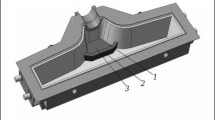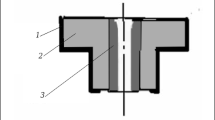Construction of a lining with a collar is developed excluding reaction of molten steel with air during operation of a section CBCM and makes it possible to provide rational parameters for feeding argon into a refractory pipe annular recess. There is an improvement in pouring stability and poured metal quality.
Similar content being viewed by others
Avoid common mistakes on your manuscript.
In spite of extensive application of plastic and other chemical synthesis products steel continues to remain the main structural material. The value of steel is due to its universality, making it possible to create numerous mechanical and other properties, geometric shapes, and object dimensions. Nonetheless, with all of the achievements of steel it is necessary to improve steadily finished product quality. A solution of this problem is provision of a nitrogen content of 0.004 – 0.007% for different grades of electric steel.
In a CBCM reaction of molten metal with air mainly occurs in the section of the steel-pouring ladle – tundish (Fig. 1). The area has three zones. In zones 0 – 0 and 2 – 2 molten steel surface is protected by special covering materials (slag-forming and heat-insulating mixes) preventing molten steel reaction with air. Zone 1 – 1 includes refractory elements (Fig. 2): a nozzle-collector 1, closely set in the bottom of a steel-pouring ladle; a protective tube 2 with an opening for argon supply into the inner circular cavity; a special lining 3 made of ductile refractory [3].
Refractory elements of zone 1 – 1 (see Fig. 1).
During passage of a steel stream in the area of the steel-pouring ladle–tundish there is erosion of refractory elements in zone 1–1 due to occurrence of a gap, through which air penetrates into the internal cavity of protective tube. The thickness of the gap may be determined from formation conditions: with thermal expansion of a quartz protective tube, with burning of a plastic refractory lining, and as a result refractory object erosion.
Thermal expansion of a quartz protective tube is governed the LTEC:
where l is specimen length after action of temperature; l 0 is specimen initial length; α is LTEC; t is specimen temperature.
In calculating thermal expansion over the inner diameter of a protective tube in it upper part Eq. (1) takes the form
where D 1610in is quartz protective tube inner diameter with heating to 1610°C; D 0in is nominal protective tube diameter at 0°C; α is LTEC, for quartz LTEC = 0.000014°C−1; t is specimen temperature, for a particular case t = 1610°C.
The thickness of a gap arising with thermal expansion of a quartz protective tube
In order to determine residual thickness a study was made of protective tubes (depleted) in the upper part. Burning of lining made of plastic refractory occurs over one side, and therefore the thickness of gap formed with burning of a plastic refractory insert comprises
The size of the protective tube erosion site (without taking account of spalling) is from 1.05 to 1.15D 0in . In order to calculate the size of a collar maximum gap thickness was adopted, formed due to refractory object erosion:
In order to create conditions preventing penetration air into the cavity of zone 1 – 1, it is necessary that the size of the collar of a protective lining exceeds gap thickness, obtained by Eqs. (3) – (5) with respect to protective tube outer diameter in its upper part:
The size of the collar obtained with respect to inner diameter of the protective tube comprises
Solution of the problem was creation of a new lining construction, having and end surface with an outer diameter less than 1.2 of the diameter of the refractory tube opening in its upper part over a plane (see Fig. 3 b). Use of a lining with diameter less than 1.2D (see Fig. 3 b), led to burning away of the end part of a lining over a contact plane of refractory objects. Use of a collar diameter greater than 1.2D of the protective tube inner diameter in its upper part led to distortion of the end part and loose attachment over this plane and correspondingly to crack formation of the end part of the lining. Therefore the value of 1.2D is rational and applicable in similar structures [2].
In order to confirm the calculation Eq. (6) obtained experiments were performed for determining the optimum size of a lining collar with respect to protective tube inner diameter. For this different linings were prepared with collar dimensions from 0.0625D to 1.6D. The empirical data obtained confirming the equation for rational collar diameter are provided in Table 1.
For further improvement of finished product quality apart from using a lining with a collar in zone 1–1 it is necessary to use a structure of manipulators providing the required pressing force in order to guarantee abutment of the contact planes of and precise centering refractory elements.
References
V. V. Averin, A. V. Revyakin, V. I. Fedorchenko, and L. N. Kozina, Nitrogen in Metals [in Russian], Metallurgiya, Moscow (1976).
V. A. Bigaev, K. N. Vdovin, V. V. Tochilkin, A. B. Velikii, D. V. Kashcheev, O. A. Marochkin, A. A. Khomenko, and S. V. Shevchenko, RF Patent 102552 MPK B 22 D 41/08, Device for protecting metal stream during pouring in a continuous billet casting machine, Claim 10.07.10, Publ. 03.10.11, Byul. No. 3.
K. N. Vdovin, V. V. Tochilkin, and O. A. Marochkin, “Use of plastic refractories of improved construction for protecting a metal stream during steel pouring in a section CBCM,” Novye Ogneupory, No. 1, 3 – 5 (2014).
Author information
Authors and Affiliations
Corresponding author
Additional information
Translated from Novye Ogneupory, No. 7, pp. 41 – 43, July 2014.
Rights and permissions
About this article
Cite this article
Vdovin, K.N., Tochilkin, V.V., Marochkin, O.A. et al. New Plastic Refractory Linings for Protecting a Metal Stream During Pouring into a CBCM. Refract Ind Ceram 55, 318–320 (2014). https://doi.org/10.1007/s11148-014-9716-x
Received:
Published:
Issue Date:
DOI: https://doi.org/10.1007/s11148-014-9716-x







